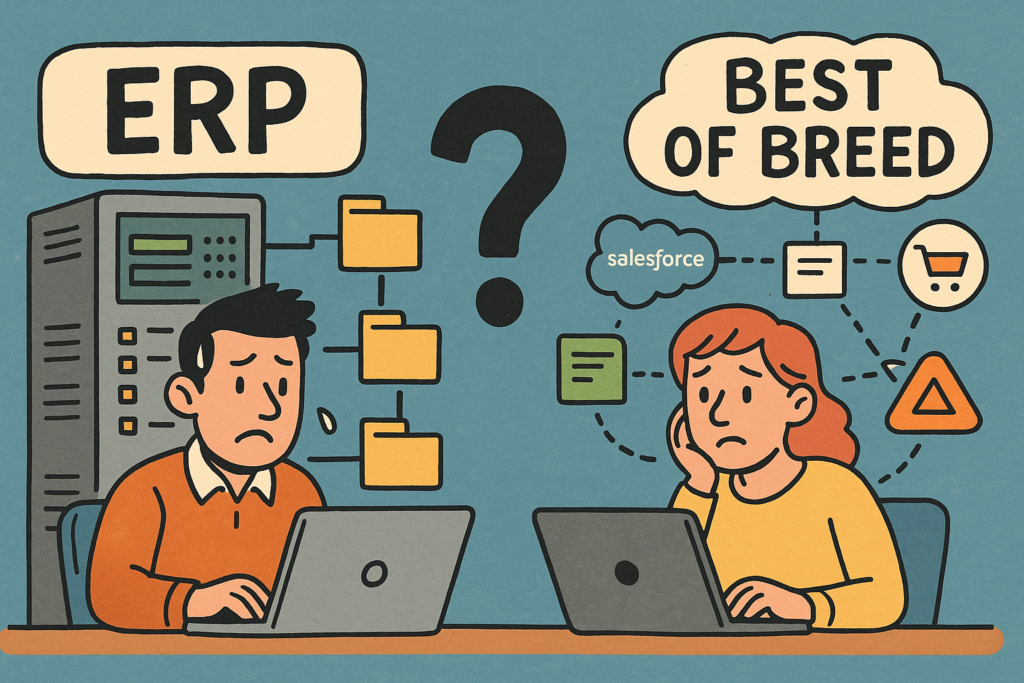The Problem with Data

Everyone has the same problem, and its name is data. Nearly every business functions in one of two core data models:
- ERP-centric: One large enterprise system (like SAP, NetSuite, or Microsoft Dynamics) acts as the hub for inventory, customers, finance, and operations. It’s monolithic, but everything is in one place.
- Best-of-breed: A constellation of specialized tools – Salesforce or HubSpot for CRM, Zendesk for support, Shopify or WooCommerce for commerce, QuickBooks for finance – all loosely stitched together, if at all.
In reality, most businesses operate somewhere in between. One system becomes the “system of truth,” while others orbit it, each with its own partial view of the business. That setup is manageable until AI enters the picture.
AI is data-hungry. It works best when it can see across your operations. But ERP vendors often make interoperability difficult by design. Their strategy has been to lock you in and make exporting or connecting data expensive or complex.
That’s why more organizations are turning to data lakes or lakehouses, central repositories that aggregate information from across systems and make it queryable. Platforms like Snowflake and Databricks have grown quickly by helping enterprises unify fragmented data into one searchable hub.
When done well, a data lake gives your AI tools visibility across departments: product, inventory, sales, finance, customer support. It’s the foundation for better analytics and better decisions.
But building a good data lake isn’t easy. I joke in my book The AI Evolution, a bad data lake is just a data swamp, a messy, unstructured dump that’s more confusing than helpful. Without a clear data model and strategy for linking information, you’re just hoarding bytes.
Worse, the concept of data lakes was designed pre-AI. They’re great at storing and querying data, but not great at acting on it. If your AI figures out that you’re low on Product X from Supplier Y, your data lake can’t place the order; it can only tell you.
This is where a new approach is gaining traction: API orchestration. Instead of just storing data, you build connective tissue between systems using APIs, letting AI both see and do across tools. Think of it like a universal translator (or Babelfish): systems speak different languages, but orchestration helps them understand each other.
For example, say HubSpot has your customer data and Shopify has your purchase history. By linking them via API, you can match users by email and give AI a unified view. Better yet, if those APIs allow actions, the AI can update records or trigger workflows directly.
Big players like Mulesoft are building enterprise-grade orchestration platforms. But for smaller orgs, tools like Zapier and n8n are becoming popular ways to connect their best-of-breed stacks and make data more actionable.
The bottom line: if your data lives in disconnected systems, you’re not alone. This is the reality for nearly every business we work with. But investing in data cleanup and orchestration now isn’t just prep, it’s the first step needed to truly unlock the power of AI.
That’s exactly why we built the AI Accelerator at PerryLabs. It’s designed for companies stuck in this in-between state where the data is fragmented, the systems don’t talk, and the AI potential feels just out of reach. Through the Accelerator, we help you identify those key data gaps, unify and activate your systems, and build the orchestration layer that sets the stage for real AI performance. Because the future of AI isn’t just about having the data—it’s about making it usable.
